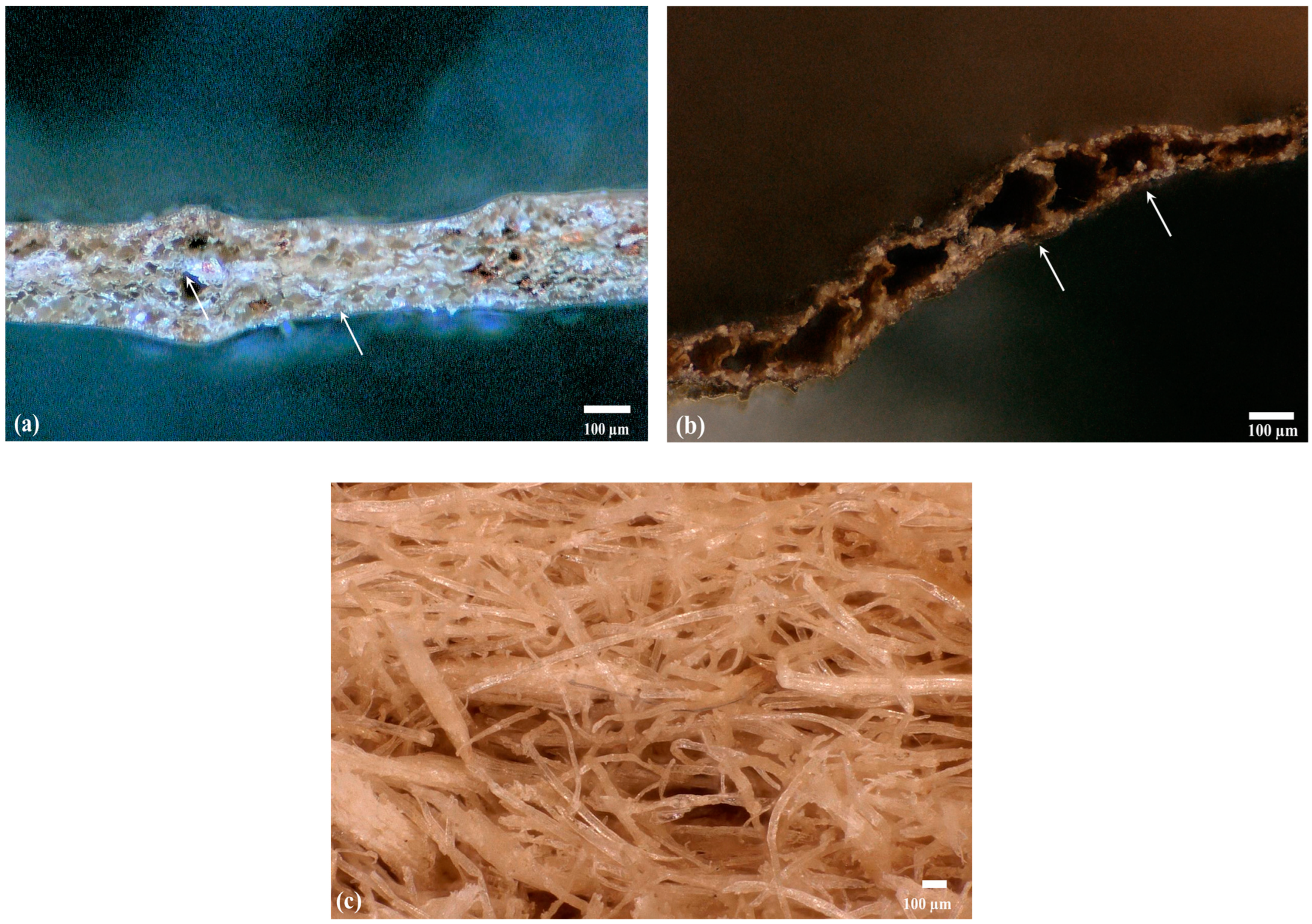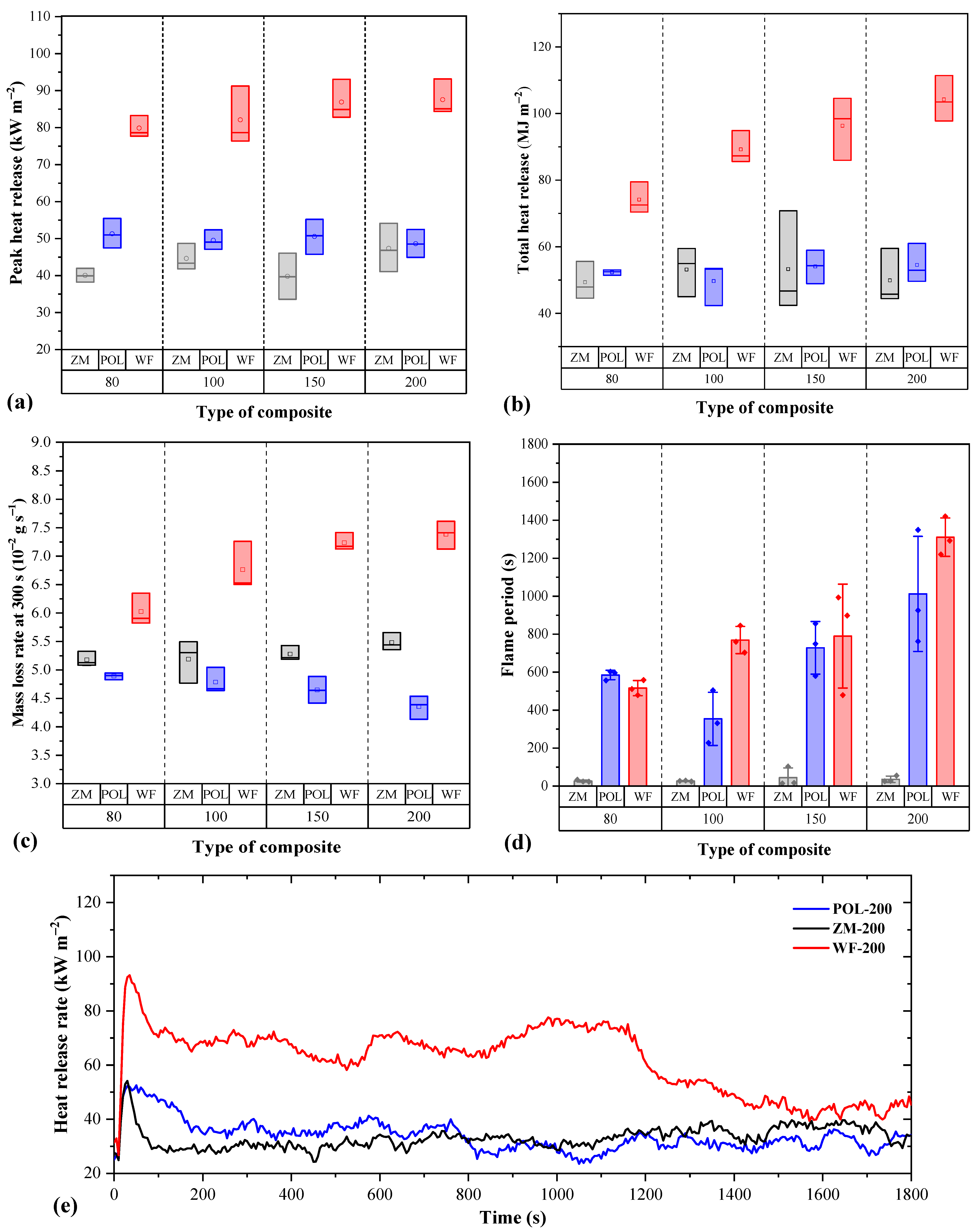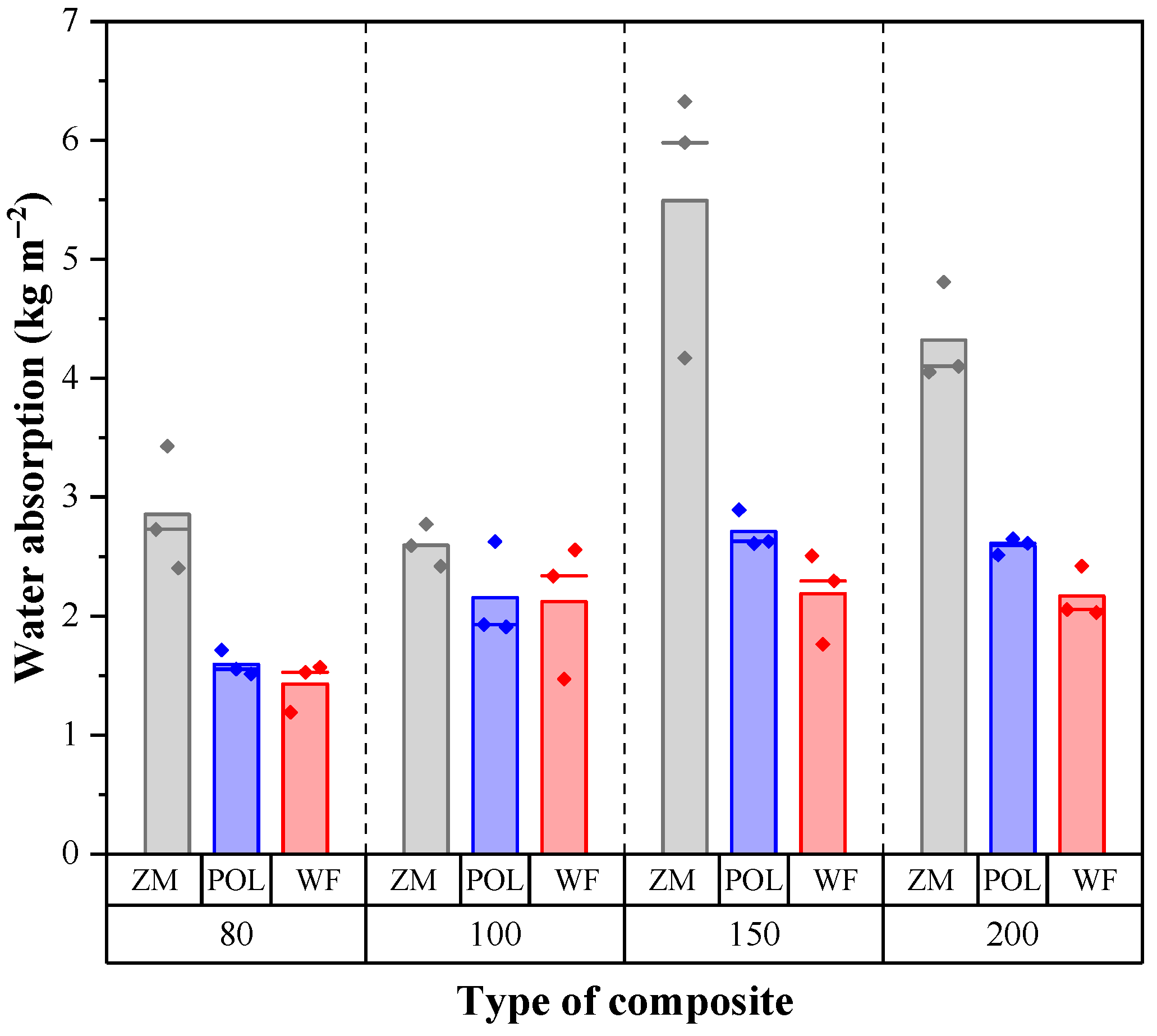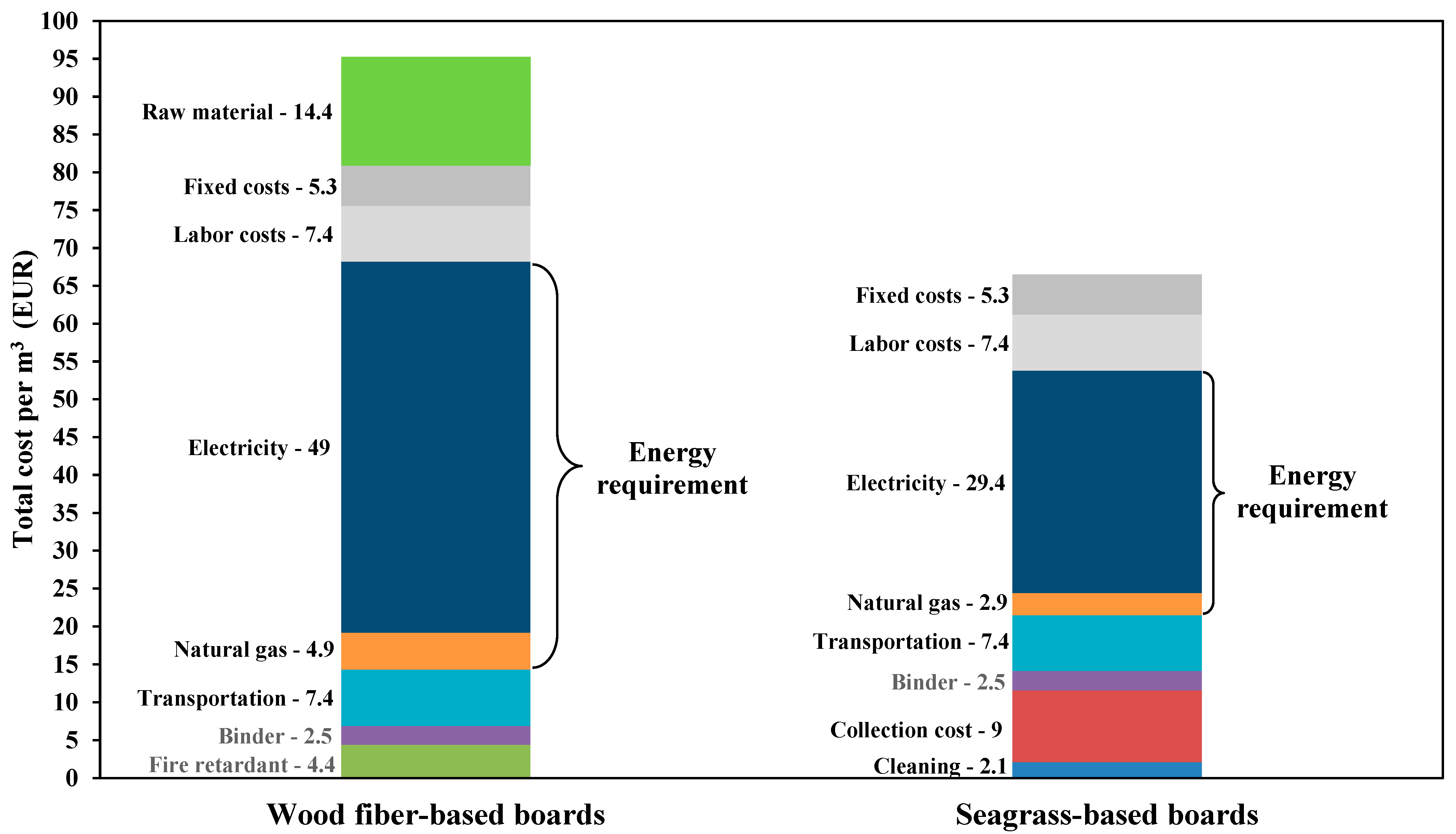Seagrass Leaves: An Alternative Resource for the Production of Insulation Materials
Abstract
1. Introduction
2. Materials and Methods
2.1. Materials
2.2. Methods
2.2.1. Determination of Morphological Characteristics
2.2.2. Chemical Analysis
2.2.3. Production of Insulation Boards
2.2.4. Mechanical Testing
2.2.5. Thermal Conductivity Measurements
2.2.6. Cone Calorimetry and Single Flame Tests
2.2.7. Water Absorption Test
3. Results and Discussion
3.1. Morphological Considerations and Chemical Composition
3.2. Mechanical Properties of Insulation Boards
3.3. Thermal Conductivity of Insulation Boards
3.4. Fire Resistance
3.5. Water Absorption
3.6. A Simplified Cost Analysis and Comparison with Other Natural Resources
4. Conclusions
Author Contributions
Funding
Data Availability Statement
Acknowledgments
Conflicts of Interest
References
- Duarte, C.M. Seagrass depth limits. Aquat. Bot. 1991, 40, 363–377. [Google Scholar] [CrossRef]
- McKenzie, L.J.; Nordlund, L.M.; Jones, B.L.; Cullen-Unsworth, L.C.; Roelfsema, C.; Unsworth, R.K.F. The global distribution of seagrass meadows. Environ. Res. Lett. 2020, 15, 074041. [Google Scholar] [CrossRef]
- Cebrian, J.; Duarte, C.M. Detrital stocks and dynamics of the seagrass Posidonia oceanica (L.) Delile in the Spanish Mediterranean. Aquat. Bot. 2001, 70, 295–309. [Google Scholar] [CrossRef]
- Vacchi, M.; Falco, G.D.; Simeone, S.; Montefalcone, M.; Morri, C.; Ferrari, M.; Bianchi, C.N. Biogeomorphology of the Mediterranean Posidonia oceanica seagrass meadows. Earth Surf. Process. Landf. 2017, 42, 42–54. [Google Scholar] [CrossRef]
- Misson, G.; Mainardis, M.; Marroni, F.; Peressotti, A.; Goi, D. Environmental methane emissions from seagrass wrack and evaluation of salinity effect on microbial community composition. J. Clean. Prod. 2021, 285, 125426. [Google Scholar] [CrossRef]
- Liu, S.; Trevathan-Tackett, S.M.; Lewis, C.J.E.; Ollivier, Q.R.; Jiang, Z.; Huang, X.; Macreadie, P.I. Beach-cast seagrass wrack contributes substantially to global greenhouse gas emissions. J. Environ. Manag. 2019, 231, 329–335. [Google Scholar] [CrossRef]
- Corraini, N.R.; de Souza de Lima, A.; Bonetti, J.; Rangel-Buitrago, N. Troubles in the paradise: Litter and its scenic impact on the North Santa Catarina island beaches, Brazil. Mar. Pollut. Bull. 2018, 131, 572–579. [Google Scholar] [CrossRef] [PubMed]
- Misson, G.; Mainardis, M.; Incerti, G.; Goi, D.; Peressotti, A. Preliminary evaluation of potential methane production from anaerobic digestion of beach-cast seagrass wrack: The case study of high-adriatic coast. J. Clean. Prod. 2020, 254, 120131. [Google Scholar] [CrossRef]
- Pfeifer, L. “Neptune Balls” Polysaccharides: Disentangling the Wiry Seagrass Detritus. Polymers 2021, 13, 4285. [Google Scholar] [CrossRef]
- Zannen, S.; Halimi, M.T.; Hassen, M.B.; Abualsauod, E.H.; Othman, A.M. Development of a Multifunctional Wet Laid Nonwoven from Marine Waste Posidonia oceanica Technical Fiber and CMC Binder. Polymers 2022, 14, 865. [Google Scholar] [CrossRef]
- European Parliament. Directive 2008/98/EC of the European Parliament and of the Council of 19 November 2008 on Waste and Repealing Certain Directives. 2008. Available online: https://eur-lex.europa.eu/legal-content/EN/TXT/PDF/?uri=CELEX:02008L0098-20180705&from=EN (accessed on 12 July 2022).
- Mainardis, M.; Magnolo, F.; Ferrara, C.; Vance, C.; Misson, G.; De Feo, G.; Speelman, S.; Murphy, F.; Goi, D. Alternative seagrass wrack management practices in the circular bioeconomy framework: A life cycle assessment approach. Sci. Total Environ. 2021, 798, 149283. [Google Scholar] [CrossRef] [PubMed]
- Balata, G.; Tola, A. Cost-opportunity analysis of the use of Posidonia oceanica as a source of bio-energy in tourism-oriented territories. The case of Alghero. J. Clean. Prod. 2018, 172, 4085–4098. [Google Scholar] [CrossRef]
- Khiari, R.; Belgacem, M.N. Potential for using multiscale posidonia oceanica waste: Current status and prospects in material science. In Lignocellul. Fibre Biomass Based Compos. Mater; Jawaid, M., Md Tahir, P., Saba, N., Eds.; Woodhead Publishing: Duxford, UK, 2017; pp. 447–471. [Google Scholar] [CrossRef]
- Ntalos, G.; Sideras, A. The usage of Posidonia oceanica as a raw material for wood composite and thermal energy production. J. Int. Sci. Publ. Mater. Methods Technol. 2014, 8, 605–611. [Google Scholar]
- Chubarenko, B.; Woelfel, J.; Hofmann, J.; Aldag, S.; Beldowski, J.; Burlakovs, J.; Schubert, H. Converting beach wrack into a resource as a challenge for the Baltic Sea (an overview). Ocean. Coast. Manag. 2021, 200, 105413. [Google Scholar] [CrossRef]
- Kuqo, A.; Korpa, A.; Dhamo, N. Posidonia oceanica leaves for processing of PMDI composite boards. J. Compos. Mater. 2019, 53, 1697–1703. [Google Scholar] [CrossRef]
- Rammou, E.; Mitani, A.; Ntalos, G.; Koutsianitis, D.; Taghiyari, H.R.; Papadopoulos, A.N. The potential use of seaweed (Posidonia oceanica) as an alternative lignocellulosic raw material for wood composites manufacture. Coatings 2021, 11, 69. [Google Scholar] [CrossRef]
- Mehrez, I.; Hachem, H.; Gheith, R.; Jemni, A. Valorization of Posidonia-Oceanica leaves for the building insulation sector. J. Compos. Mater. 2022, 56, 1973–1985. [Google Scholar] [CrossRef]
- Mayer, A.K.; Kuqo, A.; Koddenberg, T.; Mai, C. Seagrass-and wood-based cement boards: A comparative study in terms of physico-mechanical and structural properties. Compos. Part A Appl. Sci. Manuf. 2022, 156, 106864. [Google Scholar] [CrossRef]
- Ayadi, M.; Zouari, R.; Segovia, C.; Baffoun, A.; Msahli, S.; Brosse, N. Development of Airlaid Non-Woven Panels for Building’s Thermal Insulation. In Construction Technologies and Architecture; Trans Tech Publications Ltd.: Bäch, Switzerland, 2022; Volume 1, pp. 772–781. [Google Scholar] [CrossRef]
- Short, F.T.; Frederick, T. World Atlas of Seagrasses; University of California Press: California, CA, USA, 2003; p. 16. [Google Scholar]
- Wyllie-Echeverria, S.; Alan Cox, P. The seagrass (Zostera marina [zosteraceae]) industry of Nova Scotia (1907–1960). Econ. Bot. 1999, 53, 419–426. [Google Scholar] [CrossRef]
- Segovia, F.; Blanchet, P.; Auclair, N.; Essoua Essoua, G.G. Thermo-mechanical properties of a wood fiber insulation board using a bio-based adhesive as a binder. Buildings 2020, 10, 152. [Google Scholar] [CrossRef]
- Richter, M.; Horn, W.; Juritsch, E.; Klinge, A.; Radeljic, L.; Jann, O. Natural building materials for interior fitting and refurbishment—What about indoor emissions? Materials 2021, 14, 234. [Google Scholar] [CrossRef] [PubMed]
- TAPPI T 264 cm-97, Preparation of Wood for Chemical Analysis. 1997. Available online: https://imisrise.tappi.org/TAPPI/Products/01/T/0104T264.aspx (accessed on 5 July 2022).
- NREL/TP-510-42618, Determination of Structural Carbohydrates and Lignin in Biomass. 2008. Available online: https://www.nrel.gov/docs/gen/fy13/42618.pdf (accessed on 5 July 2022).
- Wise, L.E. Chlorite holocellulose, its fractionation and bearing on summative wood analysis and on studies on the hemicelluloses. Pap. Trade 1946, 122, 35–43. [Google Scholar]
- TAPPI T211 om-02, Ash in Wood, Pulp, Paper and Paperboard: Combustion at 525 °C. 2002. Available online: https://imisrise.tappi.org/TAPPI/Products/01/T/0104T211.aspx (accessed on 5 July 2022).
- DIN EN 826, Thermal Insulating Products for Building Applications-Determination of Compression Behaviour. German Version EN 826:2013, Berlin. 2013. Available online: https://www.beuth.de/de/norm/din-en-826/172014993 (accessed on 5 July 2022). German version EN 826:2013, Berlin.
- DIN EN 1607, Thermal Insulating Products for Building Applications-Determination of Tensile Strength Perpendicular to Faces. German Version EN 1607:2013, Berlin. 2013. Available online: https://www.beuth.de/de/norm/din-en-1607/171957716 (accessed on 5 July 2022).
- DIN EN 12667, Thermal Performance of Building Materials and Products-Determination of Thermal Resistance by Means of Guarded Hot Plate and HEAT flow Meter Methods-Products of High and Medium Thermal Resistance. German Version EN 12667:2001, Berlin. 2001. Available online: https://www.beuth.de/de/norm/din-en-12667/33692201 (accessed on 5 July 2022).
- ISO 5660-1, Reaction-to-Fire Tests-Heat Release, Smoke Reduction and Mass Loss Rate-Part 1-Heat Release Rate (Cone Calorimeter Method). ISO 5660-1:2002-12. 2002. Available online: https://www.iso.org/standard/35351.html (accessed on 5 July 2022).
- DIN EN ISO 11925-2, Reaction to Fire Tests-Ignitability of Products Subjected to Direct Impingement of flame-Part 2: Single Flame Source Test (ISO 11925-2:2010). German Version EN ISO 11925-2:2010, Berlin. 2011. Available online: https://www.iso.org/standard/45782.html (accessed on 5 July 2022).
- DIN EN 1609, Thermal Insulating Products for Building Applications-Determination of Short Term Water Absorption by Partial Immersion. German Version EN 1609:2013, Berlin. 2013. Available online: https://www.beuth.de/de/norm/din-en-1609/171957791 (accessed on 5 July 2022).
- Davies, P.; Morvan, C.; Sire, O.; Baley, C. Structure and properties of fibres from sea-grass (Zostera marina). J. Mater. Sci. 2007, 42, 4850–4857. [Google Scholar] [CrossRef]
- Ross, K.; Mazza, G. Characteristics of lignin from flax shives as affected by extraction conditions. Int. J. Mol. Sci. 2010, 11, 4035–4050. [Google Scholar] [CrossRef]
- Jongpradist, P.; Homtragoon, W.; Sukkarak, R.; Kongkitkul, W.; Jamsawang, P. Efficiency of rice husk ash as cementitious material in high-strength cement-admixed clay. Adv. Civ. Eng. 2018, 2018, 8346319. [Google Scholar] [CrossRef]
- Bütün Buschalsky, F.Y.; Mai, C. Repeated thermo-hydrolytic disintegration of medium density fibreboards (MDF) for the production of new MDF. Eur. J. Wood Wood Prod. 2021, 79, 1451–1459. [Google Scholar] [CrossRef]
- Zhao, Q.; Zhang, B.; Quan, H.; Yam, R.C.; Yuen, R.K.; Li, R.K. Flame retardancy of rice husk-filled high-density polyethylene ecocomposites. Compos. Sci. Technol. 2009, 69, 2675–2681. [Google Scholar] [CrossRef]
- Hakkarainen, T. Rate of heat release and ignitability indices in predicting SBI test results. J. Fire Sci. 2001, 19, 284–305. [Google Scholar] [CrossRef]
- Rocchi, L.; Paolotti, L.; Fagioli, F.F.; Boggia, A. Production of insulating panel from pruning remains: An economic and environmental analysis. Energy Procedia 2018, 147, 145–153. [Google Scholar] [CrossRef]
- Eurostat, Europpean Commission. Gas Prices for Non-Household Consumers-bi-Annual Data (from 2007 Onwards). 2021. Available online: https://ec.europa.eu/eurostat/web/energy/data/database?node_code=nrg_price (accessed on 3 August 2022).
- Ycharts.com. Germany Natural Gas Border Price. 2022. Available online: https://ycharts.com/indicators/germany_natural_gas_border_price (accessed on 3 August 2022).
- Li, J.; Pang, S.; Scharpf, E.W. Modeling of thermal energy demand in MDF production. For. Prod. J. 2007, 57, 97–104. [Google Scholar]
- Adeeb, E.; Kim, T.W.; Sohn, C.H. Cost–benefit analysis of medium-density fiberboard production by adding fiber from recycled medium-density fiberboard. For. Prod. J. 2018, 68, 414–418. [Google Scholar] [CrossRef]
- Kumar, D.; Alam, M.; Zou, P.X.; Sanjayan, J.G.; Memon, R.A. Comparative analysis of building insulation material properties and performance. Renew. Sustain. Energy Rev. 2020, 131, 110038. [Google Scholar] [CrossRef]
- Schiavoni, S.; Bianchi, F.; Asdrubali, F. Insulation materials for the building sector: A review and comparative analysis. Renew. Sustain. Energy Rev. 2016, 62, 988–1011. [Google Scholar] [CrossRef]
- Battegazzore, D.; Alongi, J.; Duraccio, D.; Frache, A. Reuse and Valorisation of Hemp Fibres and Rice Husk Particles for Fire Resistant Fibreboards and Particleboards. J. Polym. Environ. 2018, 26, 3731–3744. [Google Scholar] [CrossRef]
- Agoudjil, B.; Benchabane, A.; Boudenne, A.; Ibos, L.; Fois, M. Renewable materials to reduce building heat loss: Characterization of date palm wood. Energy Build. 2011, 43, 491–497. [Google Scholar] [CrossRef]
- Zhou, X.Y.; Zheng, F.; Li, H.G.; Lu, C.L. An environment-friendly thermal insulation material from cotton stalk fibers. Energy Build. 2020, 42, 1070–1074. [Google Scholar] [CrossRef]
- Fachagentur Nachwachsende Rohstoffe e.V. (FNR). Dämmstoffe aus Nachwachsenden Rohstoffen. Gülzow-Prüzen. Abteilung Kompetenz-und Informationszentrum Wald und Holz (KIWUH). 2019. Available online: https://www.fnr.de/fileadmin/allgemein/pdf/broschueren/Brosch%C3%BCre_Baustoffe_Web.pdf (accessed on 5 July 2022).






| Raw Material | Amount of Raw Material (g) | Amount of Binder (g) | Target Density (kg m−3) | Type of Composite |
|---|---|---|---|---|
| Zostera marina leaves | 818 | 43 | 80 | ZM-80 |
| 1023 | 54 | 100 | ZM-100 | |
| 1534 | 82 | 150 | ZM-150 | |
| 2045 | 109 | 200 | ZM-200 | |
| Posidonia oceanica leaves | 837 | 43 | 80 | POL-80 |
| 1046 | 54 | 100 | POL-100 | |
| 1569 | 82 | 150 | POL-150 | |
| 2092 | 109 | 200 | POL-200 | |
| Wood fibers | 789 | 43 | 80 | WF-80 |
| 989 | 54 | 100 | WF-100 | |
| 1479 | 82 | 150 | WF-150 | |
| 1973 | 109 | 200 | WF-200 |
| Percentile (%) | POL (Leaves) | ZM (Leaves) | WF (Fibers) | |||
|---|---|---|---|---|---|---|
| Geodesic Length (mm) | Width (mm) | Geodesic Length (mm) | Width (mm) | Geodesic Length (mm) | Thickness (mm) | |
| 0 | 5.23 | 1.03 | 0.10 | 0.04 | 0.05 | 0.02 |
| 10 | 48.39 | 3.68 | 13.48 | 0.78 | 0.63 | 0.05 |
| 50 | 78.97 | 5.71 | 36.74 | 1.56 | 2.12 | 0.06 |
| 90 | 94.32 | 7.04 | 72.22 | 3.10 | 4.61 | 0.27 |
| 100 | 99.68 | 8.09 | 86.01 | 4.29 | 16.61 | 1.65 |
| Raw Material | HWE a (%) | CEE b (%) | Lignin (%) | Holocellulose (%) | Ash (%) |
|---|---|---|---|---|---|
| ZM (leaves) | 17.9 | 1.0 | 17.5 | 44.6 | 22.0 |
| POL (leaves) | 10.9 | 4.2 | 18.7 | 54.7 | 13.9 |
| WF (fibers) | 9.0 | 2.1 | 28.3 | 66.0 | 0.5 |
| Type of Composite | Actual Density (kg m−3) | Internal Bond Strength (kPa) | Compression at 10% Deformation, σ10 (kPa) |
|---|---|---|---|
| ZM-80 | 86 ± 5 | 2.8 ± 1.2 | 17.5 ± 6.3 |
| ZM-100 | 103 ± 4 | 5.1 ± 1.0 | 24.1 ± 9.4 |
| ZM-150 | 151 ± 4 | 8.0 ± 0.9 | 42.6 ± 12.1 |
| ZM-200 | 206 ± 9 | 9.4 ± 3 | 102.7 ± 48.4 |
| POL-80 | 83 ± 8 | 2.6 ± 1.3 | 13.9 ± 3.6 |
| POL-100 | 103 ± 6 | 4.5 ± 1.4 | 15.9 ± 1.2 |
| POL-150 | 152 ± 7 | 6.7 ± 4.3 | 38.4 ± 3.1 |
| POL-200 | 209 ± 13 | 21.0 ± 6.0 | 95.4 ± 15.0 |
| WF-80 | 81 ± 3 | 10.6 ± 1.4 | 35.4 ± 2.6 |
| WF-100 | 104 ± 2 | 16.4 ± 1.5 | 56.2 ± 2.1 |
| WF-150 | 154 ± 5 | 29.5 ± 4.7 | 151.0 ± 5.8 |
| WF-200 | 202 ± 6 | 42.8 ± 6.1 | 254.4 ± 17.3 |
| Type of Composite | Bunsen Burner Analysis at the Surface for 15 s | Bunsen Burner Analysis at the Edge for 30 s | ||||||
|---|---|---|---|---|---|---|---|---|
| Ignition | Time to Flameout (s) | Soot Cone Height (mm) | Pass/Fail * | Ignition | Time to Flameout (s) | Soot Cone Height (mm) | Pass/Fail ** | |
| ZM-80 | No | n/a | 35 | Pass | No | n/a | 32 | Pass |
| ZM-100 | No | n/a | 27 | Pass | No | n/a | 30 | Pass |
| ZM-150 | No | n/a | 27 | Pass | No | n/a | 41 | Pass |
| ZM-200 | No | n/a | 28 | Pass | No | n/a | 41 | Pass |
| POL-80 | No | n/a | 35 | Pass | No | n/a | 47 | Pass |
| POL-100 | No | n/a | 32 | Pass | No | n/a | 55 | Pass |
| POL-150 | No | n/a | 31 | Pass | No | n/a | 51 | Pass |
| POL-200 | No | n/a | 31 | Pass | No | n/a | 38 | Pass |
| WF-80 | Yes | 19 | 118 | Pass | Yes | >60 | All *** | Fail |
| WF-100 | Yes | 60 | 110 | Pass | Yes | >60 | All *** | Fail |
| WF-150 | Yes | 28 | 90 | Pass | Yes | 44 | 112 | Pass |
| WF-200 | Yes | 49 | All *** | Pass | Yes | >60 | All *** | Fail |
| Insulation Type | Density (kg m−3) | Thermal Conductivity (W m−1 K−1) | Resistance to Fire | Embodied Energy (MJ kg−1) | References |
|---|---|---|---|---|---|
| EPS | 18–50 | 0.029–0.041 | E | 80.8–127 | [47] |
| Flax | 20–100 | 0.033–0.090 | C | 39.5 | [47,48] |
| Hemp | 25–100 | 0.039–0.123 | E | 18.7 | [48] |
| Kenaf | 30–180 | 0.026–0.044 | E | 22.7–39.1 | [48] |
| Rice husk | 130–170 | 0.048–0.080 | C | 1.4 | [48,49] |
| Date palm | 187–389 | 0.072–0.085 | n/a | n/a | [50] |
| Coir fibers | 50–160 | 0.040–0.050 | D-E | 0.55 | [48] |
| Cotton stalks | 150–450 | 0.058–0.082 | E | 44–48 | [47,51] |
| Wood fibers | 50–270 | 0.040–0.052 | E | 20.3 | [47,52] |
| Seagrass POF * | 70–130 | 0.037–0.043 | n/a | n/a | [52] |
| Wood fibers | 92–212 | 0.044–0.057 | E | n/a | Current study |
| Seagrass POL * | 95–233 | 0.042–0.050 | B-D | n/a | Current study |
| Seagrass ZM * | 83–213 | 0.042–0.051 | B-D | n/a | Current study |
Publisher’s Note: MDPI stays neutral with regard to jurisdictional claims in published maps and institutional affiliations. |
© 2022 by the authors. Licensee MDPI, Basel, Switzerland. This article is an open access article distributed under the terms and conditions of the Creative Commons Attribution (CC BY) license (https://creativecommons.org/licenses/by/4.0/).
Share and Cite
Kuqo, A.; Mai, C. Seagrass Leaves: An Alternative Resource for the Production of Insulation Materials. Materials 2022, 15, 6933. https://doi.org/10.3390/ma15196933
Kuqo A, Mai C. Seagrass Leaves: An Alternative Resource for the Production of Insulation Materials. Materials. 2022; 15(19):6933. https://doi.org/10.3390/ma15196933
Chicago/Turabian StyleKuqo, Aldi, and Carsten Mai. 2022. "Seagrass Leaves: An Alternative Resource for the Production of Insulation Materials" Materials 15, no. 19: 6933. https://doi.org/10.3390/ma15196933
APA StyleKuqo, A., & Mai, C. (2022). Seagrass Leaves: An Alternative Resource for the Production of Insulation Materials. Materials, 15(19), 6933. https://doi.org/10.3390/ma15196933









